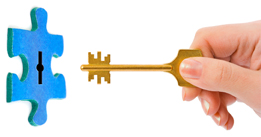Lesson 5
1. Lesson 5
1.3. Explore
Module 2: Logic and Geometry
Explore
You may have noticed as you worked through this module that inductive and deductive reasoning processes each involve a series of steps. For instance, the following steps can be used to form a conjecture and then used to prove or disprove it. Watch the animation called Steps.
Self-Check 1
- Which step or steps in the Steps animation involve inductive reasoning? Answer
- Which step or steps apply to deductive reasoning? Answer

Hemera/Thinkstock
Read “Example 1: Using reasoning to solve a problem” and “Example 2: Using reasoning to solve a problem” on pages 46 to 48 of your textbook. As you read, think about the following questions:
- What strategy was used to solve each problem?
- Was inductive or deductive thinking used in the solutions for Example 1 and Example 2?
- How do you know which type of reasoning was used?
- Did the problem-solving strategy give you any clues as to which type of reasoning was used?
As you have seen throughout this module, inductive reasoning involves observing patterns. A logical conclusion is then drawn based on these observations to solve the problem. For example, inductive reasoning was used to determine how many handshakes were exchanged by examining the pattern in the first two cases.
Deductive reasoning uses known facts or assumptions to develop an argument. This argument is then used to draw a logical conclusion and solve the problem. Vicky used deductive reasoning to determine the four pairs of partners for fun night.

Self-Check 2
